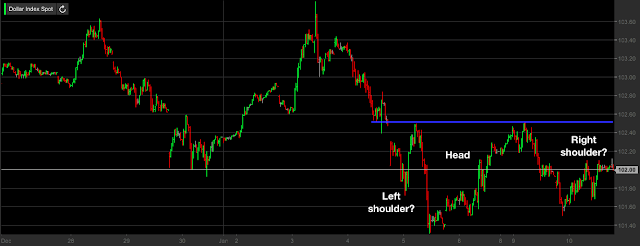Dollar Bulls Will Ride Again... If Not Now, Then Soon...
There's some shifting going on in the currency markets, especially in major currency pairs. The first image shows latest readings of the Euro (currency pair EUR/USD), which is currently in the retesting phase of a true 'head-and-shoulders' pattern. This pattern is identified by a rise in the value of a security, followed by a dip, followed by another rise, followed by another dip, and a final rise and a final dip to give the appearance of a head and two shoulders.
In the finance world, this is a 'bearish' pattern, a pattern that anticipates the value of the security will fall soon. The 'retesting' is shown right now, as we see the value of the security hovering just under that red line, called the 'neckline'. When this retesting is complete, which will happen soon, the Euro is expected to fall in value yet again, likely into the rest of January and February.
The second image shows the value of the Yen (currency pair USD/JPY). Notice another neckline shown by that red line, but this time it is an INVERSE head-and-shoulders pattern. It's that head-and-shoulders pattern, but turned upside down. Similarly, instead of being 'bearish', this pattern is 'bullish', anticipating the value of the security will rise soon. Thus, the Yen is expected to decrease in value again in the near future.
It's no coincidence that these two things are happening at the same time. When the Euro and Yen both fall in value, as is projected to happen per this technical analysis, it's typically due to the U.S. Dollar strengthening. The third image (the Spot Dollar Index, symbol DXY) shows what may well be a very messy inverse head-and-shoulders pattern in the short term, using the same time intervals as the first two images, but again it's very messy. The messy quality of this pattern throws into question a strengthening dollar.
But this question exists only briefly.
In my fourth and final image, I show you what will be a news story for the next several years. We are currently going through, if not just exiting, the retesting phase of an inverse head-and-shoulders pattern in the Spot Dollar Index, but this time it's a 20-month-long pattern instead of just a couple of days, like the first three images.
It will be a consistent news story, because it could very well usher in the next recession. A stronger dollar for the long term is favored strongly by this technical analysis in the fourth image. While it increases purchasing power of the U.S. consumer, it will increasingly trim profits of multinational companies, especially those who make the majority of their revenue from other countries. Converting those currencies into a stronger US Dollar will take more of that country's currency to make 1 USD. Over time, that hurts companies' earnings, and by extent their stock prices.
The stronger dollar will force the Federal Reserve to hike overnight lending interest rates faster than they want to, something that will squeeze the bond bull market (which is already looking shaky post-election). For companies that have been living off of easy monetary policy put into place by the Fed since the Recession, this is a big threat. If it comes to fruition is another question and another story for another day, but the threats are very real.
To summarize:
1) Short-term weakening is expected for the Euro.
2) Short-term weakening is expected for the Yen.
3) Simultaneously, strengthening is expected for the U.S. Dollar.
4) Long-term, the U.S. Dollar is expected to strengthen, and may very well be the catalyst for the end of this already very-long economic expansion.
Andrew
 |
| MyFxBook |
In the finance world, this is a 'bearish' pattern, a pattern that anticipates the value of the security will fall soon. The 'retesting' is shown right now, as we see the value of the security hovering just under that red line, called the 'neckline'. When this retesting is complete, which will happen soon, the Euro is expected to fall in value yet again, likely into the rest of January and February.
 |
| MyFxBook |
 |
| Teletrader.com |
But this question exists only briefly.
In my fourth and final image, I show you what will be a news story for the next several years. We are currently going through, if not just exiting, the retesting phase of an inverse head-and-shoulders pattern in the Spot Dollar Index, but this time it's a 20-month-long pattern instead of just a couple of days, like the first three images.
 |
| Teletrader.com |
The stronger dollar will force the Federal Reserve to hike overnight lending interest rates faster than they want to, something that will squeeze the bond bull market (which is already looking shaky post-election). For companies that have been living off of easy monetary policy put into place by the Fed since the Recession, this is a big threat. If it comes to fruition is another question and another story for another day, but the threats are very real.
To summarize:
1) Short-term weakening is expected for the Euro.
2) Short-term weakening is expected for the Yen.
3) Simultaneously, strengthening is expected for the U.S. Dollar.
4) Long-term, the U.S. Dollar is expected to strengthen, and may very well be the catalyst for the end of this already very-long economic expansion.
Andrew
No comments:
Post a Comment